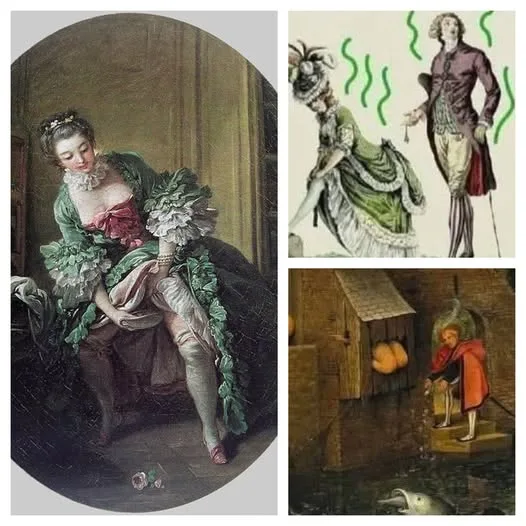We’ve all heard them: those juicy, slightly gruesome anecdotes about how people lived in the “good old days.” Tales of appalling hygiene, bizarre customs, and shocking medical mishaps often circulate online, painting a vivid (and usually quite smelly) picture of the past. While these stories are incredibly entertaining, many of them are, in fact, popular historical myths.
Let’s unpack some of the most persistent “facts” and see what the historical record actually says.

Myth 1: Versailles Was a Stinking Palace with No Bathrooms
The Anecdote: Imagine the grandeur of Louis XIV’s Versailles, yet supposedly, human excrement was regularly tossed from windows, and the entire palace reeked, forcing ladies to fan themselves to dispel odors from under their skirts.
The Reality: This is a vast exaggeration. While 17th-century hygiene wasn’t what it is today, Versailles was a marvel of its time. It had dedicated “garde-robes” (small closets with commodes or chamber pots), elaborate plumbing for fountains, and even some royal bathing facilities. Courtiers certainly relieved themselves in less formal spots when nature called urgently (especially during large gatherings), but systematically throwing waste out windows was not standard practice. Fanning was a widespread social gesture, a way to cool down, and a display of elegance, not primarily a personal odor-control device. People used perfumed waters, changed linen frequently, and certainly tried to manage body odor.
Myth 2: Weddings in June? Blame the Annual Bath!
The Anecdote: “In the Middle Ages, most marriages took place in June because people took their annual bath in May, so they still smelled ‘bearable.’ Brides carried bouquets to mask their lingering odor.”
The Reality: This is one of the most enduring and incorrect historical myths! People in the Middle Ages were far cleaner than often portrayed. While full immersion baths might have been less frequent for some than daily showers are today, people regularly washed themselves with water and cloths, changed their linen, and used herbs and perfumes. June was a popular month for weddings due primarily to favorable weather for travel and outdoor celebrations, and its association with pagan fertility festivals. Bridal bouquets, meanwhile, have roots in traditions like warding off evil spirits, symbolizing fertility, or simply being decorative.
Myth 3: Family Bathwater Was So Deadly for Babies
The Anecdote: “Families bathed in a single tub, with the head of the family first, then others by age order, leaving the water so dirty it was lethal for the last, usually the baby.”
The Reality: This is pure historical fiction. While shared bathwater might have occurred in some households due to resource constraints, the idea that the water became “lethal” for babies is a dramatic embellishment. Babies were, and always have been, given special care, and their well-being was paramount. Basic common sense would dictate that the smallest and most vulnerable would not be bathed in extremely fouled water.
Myth 4: Tomatoes Were Poisonous Due to Tin Plates
The Anecdote: “People used tin plates, and when they ate tomatoes (an acidic food), the tin would rust, causing fatal poisoning. This led to tomatoes being considered poisonous for years.”
The Reality: This myth gets a tiny bit closer to a partial truth, but it’s still largely incorrect in its common telling. Tomatoes were initially viewed with suspicion in Europe because they belong to the nightshade family, some members of which are poisonous (like belladonna). The real connection to poisoning wasn’t tin, but pewter. Pewter was an alloy that often contained lead. Acidic foods like tomatoes could indeed leach lead from pewter plates, causing lead poisoning. So, people did get sick, but it was from the lead in the pewter, not rusting tin, and the blame was often incorrectly placed on the “new” vegetable.
Myth 5: “Saved by the Bell” Comes from Being Buried Alive
The Anecdote: “Due to lack of space, graves were reused. People buried alive would scratch coffin lids, leading to the invention of ropes tied to wrists, leading to a bell outside the grave. Someone would guard it, and if the bell rang, they were ‘saved by the bell’.”
The Reality: This is arguably the most famous and persistent historical urban legend! While accidental live burials did tragically occur before modern medical science could accurately determine death, there is no historical evidence of widespread “safety coffin” practices involving bells on graves. This elaborate scenario is a Victorian-era invention, fueled by anxieties of the time. The popular phrase “saved by the bell” actually originates from boxing, where the bell signaling the end of a round can save a fighter who is in trouble from being knocked out.
The Enduring Power of a Good Story
These myths persist because they are captivating. They tap into our modern sensibilities, offering a seemingly shocking contrast to our comfortable lives. While it’s fun to imagine these scenarios, it’s important to remember that history is far more nuanced and complex (and often, less smelly!) than these popular anecdotes suggest.
Next time you hear a historical “fact” that sounds too wild to be true, take a moment to research it. You might find that the real story, while perhaps less dramatic, is far more interesting and insightful about how our ancestors truly lived.





